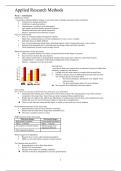Summary
Summary Applied Research Methods BC (SOW-PSB3RS35E)
- Course
- Institution
Welcome to this summary of Applied Research Methods BC (SOW-PSB3RS35E). In this document you will find the notes to all seven lectures and a summary of the literature per lecture. Domain of Brain and Cognition. Only need a summary of one week? No worries. I uploaded seven documents for every week o...
[Show more]



